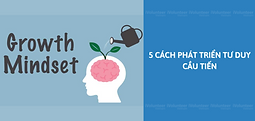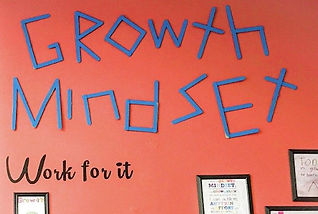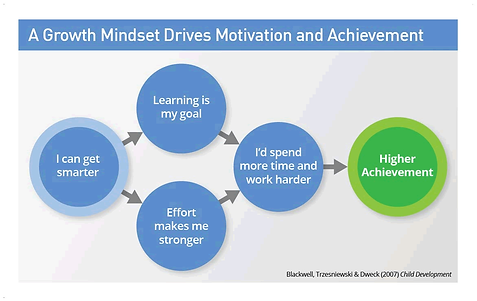Developing a Growth Mindset
According to the meta-analysis at Case Western Reserve University, despite the popularity of growth mindset interventions in schools, positive results are rare and possibly spurious due to inadequately designed interventions, reporting flaws, and bias (Macnamara & Burgoyne, 2022). With this newfound study, I will adjust my previous growth mindset plan (5302) to increase its likelihood of success.
Factors that impact the growth mindset must be considered, such as celebrating imperfection and normalizing struggle, establishing a learning environment that welcomes challenges, and utilizing diverse teaching strategies to cater to different learning styles.
Teachers have a crucial role in promoting a growth mindset in the classroom. It is essential to normalize the idea that making mistakes and encountering failure are natural parts of the learning process. Rather than praising intelligence, we should recognize and celebrate students' efforts.
The growth mindset can change how students accept feedback and their attitude toward cheating. Feedback is a valuable tool for growth and should be welcomed by students. Encouraging a growth mindset can help students shift their focus from grades to the learning process, reducing their fixation on grades. Instead of depending solely on grades, students can gauge their progress through self-review, feedback, and goal setting. Students with a growth mindset are more resilient and can quickly recover from setbacks. They are also more likely to achieve higher levels of success than those with a fixed mindset, who may plateau early on. Seeking and using feedback is crucial for faster learning, and creating a learning environment where students have choice, ownership, and voice can significantly enhance their educational experience.
Encouraging a growth mindset in students is important as it helps reduce their fixation on grades. Students driven by goals are more likely to work hard to achieve them, regardless of the obstacles. While having a growth mindset is crucial, it is also important to ensure that students follow through with their ideas to guide them in the right direction. Overemphasis on grades can lead to negative outcomes. Students may become averse to taking risks and opt for the easiest path to avoid failure. They may also start to believe they are less capable than their peers, leading to a loss of motivation. Grit is essential in reinforcing a growth mindset during middle school age, as it conveys the sustained effort and determination needed to overcome challenges and learn from setbacks. Which, in the long run, is a highly admirable character trait.
To prevent the growth mindset from becoming a fad or being improperly implemented, I will ensure that my approach is well-planned, detailed, and based on evidence. It is essential to balance challenge with support in the classroom. It is crucial to set clear expectations for students and explain how their progress will be assessed. Additionally, it is important to recognize students' efforts and strategies and offer suggestions for improvement. Teaching methods should be adjusted to accommodate different learning speeds, and student input and creative exploration should be encouraged. Motivating students to think about their learning and manage their progress and showing them that you believe in their ability to grow and develop is also important. Creating a supportive culture involves building a collaborative environment where students feel supported and recognizing and celebrating students' achievements and progress.
When misused, grit should not be an excuse for excessive rigor. This can lead to burnout and student resistance. Instead, it should be about cultivating resilience and a love for education.
It is important to mention that while the growth mindset is valuable, more is needed. Encouraging learners to embrace a Learner's Mindset is crucial. This mindset revolves around curiosity, openness, and a genuine desire to comprehend, placing it at the core of the learning process. By cultivating a Learner's Mindset, individuals view every new experience as an opportunity to gain knowledge. Those with this mindset can adapt to their environment and obtain new knowledge more efficiently.
Focusing on learning and creating significant learning environments has influenced my innovation plan of incorporating e-portfolios in the ESL science-sheltered classroom. I will celebrate imperfection, normalize struggle, establish a learning environment that welcomes challenges, and utilize diverse teaching strategies to cater to different learning styles. Doing so can foster a growth mindset by encouraging students to focus on their progress and learning journey rather than just the end result, creating a collaborative environment where students feel supported.
Importance of the Growth Mindset
Why is the growth mindset so important? Before answering that question, ask yourself: How did your mindset form? Dweck's research shows that most mindsets were formed due to praising and labeling from your childhood teachers and parents (Jeffery,2024). Transitioning to middle school can be tough for anyone, let alone a student moving into a new country who doesn't speak the language fluently. Expectations in academics to perform and personal responsibility to navigate their new world are challenges they have never had before.
To cultivate a Learner's Mindset in our students, we must encourage their curiosity, foster a love for learning, and create an environment where they feel comfortable asking questions. This means emphasizing the hard-core value of learning, rather than just seeking external validation. Even in the face of challenges, students with a growth mindset continue in working towards their goals, viewing setbacks as opportunities for growth. They embrace learning as a positive experience, rather than a basic task to completed. By producing a growth mindset, we empower students to develop resilience and a genuine passion for learning that will enrich all aspects of their lives.
Growth Mindset in Four Steps
Step 1 - Learn to hear your fixed mindset “voice.”
Step 2 - Recognize that you have a choice
Step 3- Talk back to it with a growth mindset voice
Step 4- Take the growth mindset action (Dweck, 2016)
1
How to Incorporate the Growth Mindset
2
3
4
Model recognizing and acknowledging the fixed mindset voice. This voice has the potential to hinder progress and make students want to quit when things get tough. Model steps to quiet this voice so that students can continue to grow and move forward.
5
In an educational setting, it is vital to consistently demonstrate and foster a growth mindset among students. This involves cultivating an environment that encourages resilience, perseverance, and a belief in the ability to develop intelligence and talents through dedication and hard work.
Teaching methods should be adjusted to accommodate different learning speeds, and student input and creative exploration should be encouraged.
6
It's important to create an environment where making mistakes and experiencing failure is seen as a normal part of the learning process. This can be achieved by sharing personal stories of failure and mistakes, as well as using examples from other people's experiences.
Creating a supportive culture involves building a collaborative environment where students feel supported and recognizing and celebrating students' achievements and progress.
7
Educate students about the significance of feedback in the learning process, emphasizing that constructive criticism helps identify areas for improvement, reinforces positive performance, and fosters continuous growth and development.
Balance challenge with support in the classroom. It is crucial to set clear expectations for students and explain how their progress will be assessed. Additionally, it is important to recognize students' efforts and strategies and offer suggestions for improvement.
8
Encouraging a growth mindset can help students shift their focus from grades to the learning process, reducing their fixation on grades. Instead of depending solely on grades, students can gauge their progress through self-review, feedback, and goal setting.
Promoting the Growth Mindset
Combining the promotion of a growth mindset with other interventions can maximize its effectiveness(Harapnuik, 2019). There is increasing evidence to indicate that altering the learning environment and providing learners with choice, ownership, and opportunities for authentic learning could significantly enhance the impact of these interventions, such as celebrating imperfection and normalizing struggle, establishing a learning environment that welcomes challenges, and utilizing diverse teaching strategies to cater to different learning styles.




Impact of the Growth Mindset
In a safe learning environment, having a positive attitude and being motivated to face challenges is really important. For students who are learning English, it can be hard in the beginning because they may feel shy. I have a plan to use e-portfolios in the science class for these students. This means they can use a special online space to look at and think about their work. It will help them work together with other students and show what they have done well. This can help them feel good about their progress and how they are learning, rather than just thinking about the final grades.

References
Dweck, C. S. (2006). Mindset: The new psychology of success. New York: Random House.
Harapnuik, D. (2019, April 5). How to Grow a Growth Mindset. Harapnuik.org. https://www.harapnuik.org/?p=7955
Jeffery, S. (2024). How to Change Your Mindset from Fixed to Growth: A Definitive Guide.
https://scottjeffrey.com/how-to-change-your-mindset/#How_to_Change_Your_Mindset_4-Steps
Main, P (2022, February 09). Growth Mindset: A teacher's guide.
https://www.structural-learning.com/post/growth-mindset-a-teachers-guide
Macnamara, B. N., & Burgoyne, A. P. (2022). Do growth mindset interventions impact students’ academic achievement? A systematic review and meta-analysis with recommendations for best practices. Psychological Bulletin, 149(3-4). https://doi.org/10.1037/bul0000352
Mindset Works. (2017). A Growth Mindset Drives Motivation and Achievement.
https://www.mindsetworks.com/science/Default
Moore, C.S. (2018). Five Ways to Teach Students to Be Learning Centered, Too.
https://www.facultyfocus.com/articles/teaching-and-learning/five-ways-to-teach-students-to-be-
learning-centered-too/
UNC Learning Center.( 2012, June 26).Growth Mindset [Video] https://www.youtube.com/watch?v=JfdoJxPjp1k
TED. (2014, September 12). The power of yet | Carol S Dweck | TEDxNorrköping[Video].YouTube.
https://www.youtube.com/watch?v=J-swZaKN2Ic&t=17s
Wells, R. (2024). Three Ways to Develop a Growth Mindset as a Leader.
https://www.forbes.com/sites/rachelwells/2024/01/26/3-ways-to-develop-a-growth-mindset-as-a-leader/
